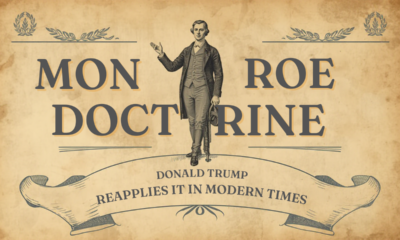Executive
The Inequality Hoax
Inequality, according to this reviewer, is a hoax meant to justify government programs that make things worse for everyone.

The following review is part of RealClear Books & Culture’s symposium on The Myth of American Inequality.
Too many crises to take seriously
Americans should be forgiven if they are suffering from a condition that might be called “crisis overload.” After all, thanks mostly to liberals and progressives, they have had to deal with an unending series of crises over the past many decades, beginning in the 1960s with the “poverty crisis” and an “urban crisis,” followed in the 1970s and 1980s by the “environmental crisis,” the “energy crisis,” and the “homeless crisis.” Later, once again thanks to progressives, Americans were asked to confront the “health care crisis” and the civilization-threatening “global warming crisis.”
It is a good question whether any of these represented genuine crises, rather than ongoing challenges better dealt with by gradual or incremental measures, if at all. On the other hand, some have found it useful to turn multi-faceted problems into crises in order to stampede the public into adopting policies it would otherwise (quite sensibly) reject. As a prominent Democratic Party official observed, “It is a mistake to let a good crisis go to waste.”
The inequality crisis
The new calamity of the hour is “the inequality crisis,” another issue progressives have promoted as a reason to raise taxes, attack “the rich,” and discredit policies that have given Americans several decades of prosperity, booming real estate and stock markets, and an expanding global economy. The Economist magazine wrote a few years ago that inequality in wealthy countries is high and still rising, certainly a crisis according to the editors of the magazine. Sen. Bernie Sanders observed recently that “the obscene and increasing level of wealth and income inequality in the United States is immoral, un-American, and unsustainable.”
The Democratic Party, in its quadrennial platforms, claims that the economy is “rigged” against working people, and that the wealthy have captured ever larger shares of national income in recent decades. Authors have churned out an unending series of books and essays calling attention to the “inequality crisis,” and challenging national leaders to do something about it. These critics agree that the American economy has been dysfunctional for several decades now, ever since President Reagan cut taxes and regulations in the 1980s, and set in motion a shift toward market-based policies in America and around the world.
Were free markets a mistake?
These claims about the “inequality crisis” have thus been advanced to make a larger point – that the United States and other major countries made a mistake in the 1980s by embracing free markets, and scaling back taxes, regulations, and other interventions by government into the economy. These changes in direction, they argue, created the inequality crisis, and wrecked the American dream whereby children could be expected to earn more than their parents. As an essay in The Atlantic put it:
Over the course of a few decades, the chances of achieving the American dream went from a near-guarantee to a coin flip. What happened? One answer is that American voters abandoned the system that worked for their grandparents. From the 1940s through the ’70s, sometimes called the New Deal era, U.S. law and policy were engineered to ensure strong unions, high taxes on the rich, huge public investments, and an expanding social safety net. Inequality shrank as the economy boomed. Ronald Reagan took office promising to restore growth by paring back government, slashing taxes on the rich and corporations, and gutting business regulations and antitrust enforcement.
It follows from these premises that the solution to the inequality crisis, and to accompanying problems of economic stagnation and the loss of social mobility, lies in reversing the “Reagan revolution,” as many progressives are urgently trying to do.
The inequality hoax
But is it really true that inequality is growing, that the American dream is dead, and that the American economy has been working in reverse since the 1980s? Perhaps not. There is another perspective to consider: that claims about inequality are based upon faulty statistics and lack of appreciation for the real economic progress that has taken place over recent decades. From that point of view, the “inequality crisis” might be rebranded as the “inequality hoax.”
This is the argument put forward recently by former U.S. Senator Phil Gramm, the late Robert Ekelund, and John Early in their book, The Myth of American Inequality: How Government Biases Policy Debate (2021). The authors know whereof they speak: they are veterans of policy debates in Washington, and are skilled in marshalling and interpreting government statistics about inequality and the distribution of incomes. This book contains the most careful and detailed analysis available about the broad effects of welfare state transfers on the incomes and living standards of Americans in all income groups, especially those in the bottom twenty percent of the income distribution.
Reports of growing income inequality are greatly exaggerated
The authors argue, in a nutshell, that claims of growing income inequality are greatly exaggerated due to biases in the ways by which government measures incomes. There are two flaws: first, federal agencies do not include non-cash transfers in measures of income for those who receive them; second, the same agencies fail to consider the effects of taxes on the incomes of wealthier Americans who are required to pay them. When the full array of government transfers and benefits are taken into account, along with taxes paid across the board, the gaps in income between the wealthy and the poor shrink back to where they were prior to 1980. This is an important argument, and one that politicians and policy-makers should take into account when crafting tax and welfare policies.
These are the key points made in the course of this carefully documented argument:
Distribution of earned income
1. The authors acknowledge that the distribution of earned income has evolved in a much more unequal direction since the 1960s. During the 1940s and 1950s, the ratio in earned income between the top quintile and bottom quintile of the distribution was about 5.6 but by 2017 had grown to a staggering 60 to 1 (with earned income defined as wages, salaries, employer paid benefits, and investment income, but without government transfers). In the earlier period, most of those in the bottom quintile who were not retired were attached to the work force, and supported themselves via salaries and wages. That is no longer the case – and is a prime reason for the rise in inequality in earned incomes.
Recently, as of 2017, the bottom quintile (20%) of households took in about $5,000 in earned income, compared to $300,000 for the top quintile. That is a large gap, and one critics of the U.S. economy never tire of pointing out. But, in a point not as widely cited, the distribution of income is much more compressed when the bottom quintile is left out of the equation. The ratio in earned incomes between the top and middle quintiles is only about 3 to 1, or about $300,000 for the highest quintile and $66,000 for the middle quintile. This suggests, as the authors emphasize, that inequality in earned income is mostly an issue with the bottom 20 percent of households which no longer rely much on income from salaries and wages.
When you pay people not to work,…!
(Note: There are about 125 million households in the United States, and thus about 25 million in each quintile of the population.)
The authors devote a great deal of attention to the causes of this situation. The main reason, as they argue, is that the bottom quintile of households has been decoupled from the work force, and get by mostly on government transfers than through salaries or wages. For example, just 36 percent of those in the bottom quintile of working age were actually employed, compared to close to 100 percent for those in the highest quintile and 85 percent of those in the second quintile. In addition, those in the bottom quintile who were employed put in just 17 hours of work per week, compared to 32 hours for those in the second quintile, 36 hours for those in the middle, 38 hours for those in the fourth, and close to 40 hours per week for those in the highest quintile.
Transfer payments as an incentive creating inequality
Authors Gramm, Ekelund, and Early leave no doubt as to why this has happened, and why the bottom 20 percent of households have “decoupled” from the work force. The various Great Society programs, Medicare, Medicaid, welfare, poverty subsidies of various kinds, have made it possible for large numbers of Americans to live quite well without joining the work force, and putting in the effort required to earn incomes and move up through the income ladder. These government programs, which have expanded over a half century, discourage work, and dilute incentives for education and training that might lead to higher incomes through work. These authors are far from the first to make this point, but they document it in irrefutable terms.
In any case, as they argue, inequality in incomes is due almost entirely to incentives put in place by the modern welfare state, and have little or nothing to do with the Reagan revolution, federal tax policies, or any number of other bogeymen that have been trotted out to account for it.
The poor earn much more than gets reported
2. This is far from the end of the story, because it is well known from other government statistics that the poorest households consume much more than they earn by a factor of two or three. They are able to do this because their actual incomes are far greater than reported by the Census Bureau, the Bureau of Labor Statistics, or the Congressional Budget Office.
Government agencies, mainly the Census Bureau, choose not to include most transfer payments made by federal, state, and local governments in the calculation of incomes for recipients of those payments. In 2017, as they write, the three levels of government redistributed $2.8 trillion, or 22 percent of gross household income, to households with varying levels of income, mostly through old-age pensions, health care programs, welfare, food stamps, and a multitude of other programs. Roughly 68 percent of those funds went to households in the bottom two income quintiles. A different portrait of equality and inequality emerges when these transfers are factored into incomes.
The biggest transfer programs
The major transfer programs that supplement earned incomes are: Social Security (old age pensions), Social Security Supplemental benefits for disabled Americans, Medicare (mostly for seniors), Medicaid (health care for the poor), food stamps (now called SNAP, for Supplemental Nutrition Assistance Program, and welfare (called TANF, for Temporary Aid to Needy Families), plus other programs that provide assistance through rent and energy assistance, Pell grants for higher education, and cash payments from refundable tax credits. Among these programs, the Census Bureau counts only Social Security payments in the calculation of incomes. These omissions account for much of the misunderstanding surrounding the distribution of income.
It turns out, when transfers are added to the calculation, the poorest quintile of households received an eye-popping $45,389 in total cash and in-kind benefits in 2017, bringing their average incomes up to around $50,000 in that year. Put differently, these transfers represented more than ten times the value of earned income in these households. By comparison, the top two income quintiles, making up 40 percent of households, received small sums of less than $10,000 per household that barely affected their total incomes. By this measure, the income ratio between the top and bottom quintiles is more like 5 or 6 to one, rather than 60 to 1 when measured by earned income, or 15 or 20 to one according to official government calculations.
Recalculating poverty measures for a real measure of inequality
The authors also recalculate measures of poverty when taking these transfers into account. The Census Bureau has estimated the official poverty rate to be about 12.5 percent of individuals or households, using the traditional measures of income. That figure has been stable for several decades, which leads some experts to conclude that America’s “war on poverty” has stalled. Sen. Gramm and his co-authors beg to disagree. According to their calculations, the real poverty rate, with transfers added in, is closer to two or three percent. Those who remain below that line are probably those who are most difficult to help – the mentally ill, addicts, homeless, alcoholics, and the like. By that measure, the “war on poverty” of the 1960s succeeded – at least up to a point.
The poor are slightly less poor, but hit a ceiling
3. The authors add a caveat in regard to the poverty rate and the success of various welfare transfers in reducing poverty. They point out that this success has been achieved by decoupling the poorest households from the work force, thereby placing a ceiling on their capacity to advance by taking jobs, adding skills, and moving upward through the income ladder. By and large, those in the poorest households do not work, or work only episodically or part-time, and so must rely upon government transfers for food, shelter, and health care. We have solved the poverty problem at the cost of enmeshing the poorest households in a web of government transfers from which they find it difficult to escape. Something may have been gained in reducing poverty, but something also has been lost in the process.
Progressive taxation
4. The income distribution is compressed further when the effects of taxes are taken into account. The United States has a steeply progressive income tax system compared to other countries in the degree to which taxes are paid by the wealthiest households. The bottom two quintiles of households pay little in the way of federal income taxes, since through a series of reforms going back to the 1980s, they have been taken mostly off the tax rolls. In 2022, for example, the bottom quintile took in about four percent of pre-tax income and paid just one percent of federal income and payroll taxes. On the other hand, the top quintile earned 53 percent of pre-tax income, but paid 67 percent of all federal taxes, including income and payroll taxes and estate taxes.
Those who promote the “inequality crisis” argue that the United States should return to the high tax regime in place during and after World War II when incomes (they claim) were more equal than today. During the 1950s, the top marginal rate for US income taxes was 91 percent, before Presidents Kennedy and Johnson reduced it to 70 percent and President Reagan reduced it further to 50 percent (that rate is 37 percent today).
The deductions meant scarcely anyone paid 91 percent at margin
Yet as Sen. Gramm and his co-authors point out, hardly anyone paid that confiscatory rate during the post-war era, choosing instead to take advantage of an array of deductions and exemptions that were available at that time. As they point out, the wealthy are paying a higher effective tax rate – the percentage of income actually paid – than in the 1950s. The top one percent of earners, for example, pay an effective rate of nearly 30 percent today, compared to an effective rate of less than 20 percent in 1960.
The tax factor is rarely taken into account in studies of income inequality, though it is well known that the highest income groups pay the lion’s share of state and federal taxes. The authors of this study estimate that when taxes are taken into account, the income gap between the top and bottom quintiles shrinks to a ratio of 4 to 1 – not a gap that justifies claims of an “inequality crisis.”
Social mobility and failure to track individual performance
5. This book also shows, drawing upon abundant and reliable data, that social mobility – the American dream – is alive and well in America. Working Americans can still expect over their lifetimes to exceed the earnings of their parents in large part due to the continuing growth of the U.S. economy due to the productivity of its workers and vast amounts of capital invested to assist them.
The pessimistic view that workers are frozen in their current economic positions arises from a faulty approach to the data. The researchers who make this argument use economic quintiles as they appear over time rather than the movement of individuals and their incomes over time. When the latter type of information is used, we readily see that workers move up, sometimes down, and through the income ladder over their lifetimes.
Drawing upon information gleaned from anonymous tax returns supplied by the U.S. Treasury, they show that over a ten-year period from 1987 through 1996, 46 percent of those in the bottom income quintile moved into a higher quintile in that period, while 78 percent of those in the next quintile also increased their earnings sufficient to move into higher quintiles.
People do move down from the top
Surprisingly, more than 40 percent of those in the top quintile moved downward into other quintiles by 1996. They repeated this study for the next ten-year period running from 1996 through 2005 and discovered a similar degree of movement up and through the income quintiles. The point is that workers in America do not occupy stationary positions, but begin their careers in the bottom quintiles, but advance over the years as they acquire education and gain experience in their chosen fields. That continues to happen in the United States, and shows no signs of slowing down.
They also show, using similar individual level data, that almost 90 percent of adult children have real incomes in the 21st century that are higher than their parents’ real incomes during the 1960s. This is true of those in the bottom four quintiles, or 80 percent of the working population, between the years 2000 and 2008, in comparison to the earnings of their parents 40 or so years before. The only exception pertains to those in the highest quintile, of whom only 70 percent managed to surpass the real incomes of their parents.
This proves as false the claim that Americans today cannot expect to earn as much as their parents of a generation ago. Nearly 90 percent of working Americans do so. The American dream, as Sen. Gramm and his co-authors emphasize, is alive and well today.
To address any genuine inequality, first get your facts straight
6. The authors set forth several recommendations that they think might help policy-makers in addressing issues of inequality, mobility, and economic growth. The starting point, they stress, lies in getting our facts straight. Their book shows that the federal government has used measures of income that overstate the degree of income inequality by a factor of four, or perhaps more. Income inequality, they emphasize, is falling in the United States, and not increasing. The use of reliable data, taking taxes, inflation, and transfer payments into account, is a necessary first step in analyzing these issues.
They call upon policy-makers to address the disincentives for work built into government welfare and poverty programs. Today roughly 18 million individuals in the bottom two income quintiles live in significant measure on government transfer payments, and live outside the work force through which they might improve their incomes, and their lives. They call for work requirements for many welfare programs as a means of re-engaging recipients with the work force.
They also call for improvements in education, especially for those in the bottom quintiles, through school choice, charter schools, and other reforms, most of which are resisted by the groups controlling the public school system. In general, the authors see governments at all levels as barriers to opportunity and mobility, due to the inflexibility of various transfer programs and educational institutions. This is, to some degree, a cry in the wilderness. The authors are correct – but is anyone really listening?
The Devil and his advocates for an inequality crisis
Thomas Piketty, in Capital in the Twenty-First Century (2014), the most influential of the volumes making the case for “the inequality crisis,” claims that we are living through a new “gilded age” of extravagant wealth and lavish expenditures enjoyed by a narrow elite at the expense of everyone else. As with the original “gilded age” of the late 19th century, the wealth accruing to the few gives the illusion of progress and prosperity, but conceals growing hardships and economic difficulties endured by the rest of the population. Much of his thesis rests upon this proposition: our era is one of faux prosperity.
Piketty divides the history of modern capitalism into three phases: first, the original “gilded age,” running in Europe from roughly 1870 to the outbreak of World War I in 1914 (he often refers to it as the Belle Epoque) and in the United States from the end of the Civil War to the stock market crash in 1929; second, the “golden age” of social democracy from 1930 to 1980 when progressive tax regimes and welfare programs were installed in most industrial countries; and, third, the new “gilded age” beginning in 1980 and running to the present during which these tax regimes were dismantled, marginal rates and capital gains taxes were reduced, and wealth and income began to flow once again to the very rich.
Rearranging of weaith and incomes was not all
He documents these three historical phases with data and charts showing that the shares of wealth and income claimed by the top one percent or ten percent of households peaked in the early decades of the 20th century, then declined and stabilized in the middle decades of the century, and then began to rise again after 1980.
He may have a point – but only if one accepts the premise that these multi-faceted regimes can be assessed on the basis of the single criterion of wealth and income distribution or that the essence of the capitalist order is found solely in returns to capital and in the distribution of wealth and incomes. In each of these eras, there was much more going on than simply the re-arranging of wealth and incomes.
This is the broad argument that authors Gramm, Ekelund, and Early examine, and emphatically reject. They put it this way:
Over the last fifty years, the American economy has outperformed all other large, developed economies. Within the broad framework of strong economic growth, the benefits of this prosperity have been widely shared. Income differentials that existed fifty years ago on the basis of race, ethnicity, sex, age, and region have narrowed. The much-maligned last half century has been a period of astounding progress that in any country except America, would warrant the title of a golden age.
That is a conclusion that they fairly draw on the basis of their careful analysis of income statistics. It also happens to be true.
Even Keynes did not despair of the pre-War era
No less an authority than John Maynard Keynes looked back upon the pre-war era in Europe as a “golden age” of capitalism. “What an extraordinary episode in the economic progress of man that age was which came to an end in August, 1914,” he wrote in 1919 in The Economic Consequences of the Peace. He marveled at the economic progress made across the continent after 1870 following the unification of Germany. Industry and population grew steadily as trade across the continent accelerated, widening the sphere of prosperity and the reach of modern comforts.
In the United States, rapid growth, stable prices, and high real wages drew millions of immigrants from Europe to build railroads, work in factories, and industrialize the country. Far reaching innovations – electricity, the telegraph, mass produced steel, and motored cars — drove the industrial process forward, and made a few people very rich. It was the first era of globalization and open trade. These three factors – innovation, emigration toward emerging centers of wealth, and widening circles of trade – have been key elements of “golden ages” throughout history. This one ended in 1914 in Europe and in 1929 in the United States.
Social democracy is overrated
The so-called “golden age” of social democracy – from 1930 to 1980 — has much to commend it; one should not gainsay the genuine economic and social progress achieved in the United States and elsewhere during the middle decades of the century. Nevertheless, the virtues of that era can be overstated. As Piketty acknowledges, much of the accumulated capital of the preceding era was wiped out by war and depression. The confiscatory tax rates of that era, with marginal rates as high as 91 percent in the U.S. in the 1940s and 1950s, played a secondary role in the relative equalization of wealth and incomes.
The impressive growth rates of the 1950s and 1960s developed from a depressed base and by building out innovations from the earlier period. Labor unions grew and won impressive wage gains for members, but mainly because (in the United States) they were bargaining with domestic oligopolies in the auto, steel, railroad, aluminum, and other industries. The structure of American industry was highly concentrated which, in the opinion of some, impeded innovation. John Kenneth Galbraith wrote in The New Industrial State (1967) that cartelization was a permanent feature of the U.S. economy. There was little immigration into the United States and Western Europe between 1930 and 1970. Most importantly for the distribution of wealth, the U.S. stock market barely moved in real terms between 1930 and 1980; in 1980, the Dow Jones Industrial Average was at a lower level (adjusted for inflation) than at its 1929 peak.
The high taxes brought many social ills
The high tax regime of that era collapsed in the 1970s, not because “the rich” dismantled it, but because government spending and regulation brought with them more crime, dependency, and disorder, along with simultaneously growing rates of unemployment and inflation. It was Jimmy Carter who first led the charge to deregulate the airline, railroad, trucking, and communications industries. Democrats and Republicans alike agreed that the U.S. economy was suffering from a shortage of capital – and that tax rates should be reduced to promote capital formation. At the same time, U.S. leaders pushed successfully for the elimination of trade barriers and a more open international trading system. Piketty’s “golden age” collapsed of its own weight.
One might easily echo those comments about the pre-war era in Europe in reflecting upon the era through which we have lived from the 1980s to the present. Far from being a “gilded age,” it appears from a broader perspective to have been a new “golden age” of capitalism, marked by life changing innovations in technology, globalized markets and widening circles of trade, unprecedented levels of immigration into centers of prosperity, the absence of major wars, rising living standards around the world, low inflation and interest rates, and a forty-year bull market in stocks, bonds, and real estate. At the same time, the boom in financial assets and real estate has also enriched the endowments of colleges, universities, and foundations, along with pension and retirement funds upon which millions of households depend.
Inequality hoaxers want to punish the prosperous – which even Keynes didn’t advocate
These developments broke up the concentrated structure of the U.S. economy, making it more open, competitive, and innovative. At the same time, corporate profits are far higher now than in the age of industrial concentration and oligopoly. The end of the Cold War and the entrance of China into the world economy similarly broke open the structure of world politics and finance that dominated the middle decades of the century. While some have won incredible riches in this new age of capitalism, they have not done so at the expense of anyone else but rather by developing new products and technologies of benefit to all or by investing in enterprises that earn profits by satisfying customers.
Keynes once remarked that the challenge in such a situation is to keep “the boom” going, not to bring it to a premature end out of a superstition that those who have prospered must be punished. That error has been made at various times in the past, most recently in the 1930s. It may be inevitable that our “golden age’ will end sooner or later – but much sooner if Professor Piketty and his fellow “hoaxers” have their way.
This article was originally published by RealClearBooks Symposium and made available via RealClearWire.
James Piereson is a Manhattan Institute senior fellow and president and trustee of the William E. Simon Foundation.
-

 Executive1 day ago
Executive1 day agoWaste of the Day: Can You Hear Me Now? No.
-

 Civilization5 days ago
Civilization5 days agoTen Reasons To Cheer the Arrest of Maduro
-

 Civilization1 day ago
Civilization1 day agoTrump’s version of the Monroe Doctrine
-

 Civilization3 days ago
Civilization3 days agoOne Fell Swoop: Lawsuit Eyes Death Blow to Racial Preferences
-

 Civilization2 days ago
Civilization2 days agoTrump’s New Doctrine of Precision Deterrence
-

 Civilization22 hours ago
Civilization22 hours agoThe Snatch and Grab of Maduro Was Not ‘Illegal’
-

 Civilization22 hours ago
Civilization22 hours agoThe Mission to Extradite Nicholas Maduro
-

 Executive3 days ago
Executive3 days agoWaste of the Day: $1.6T in Wasteful Spending in Rand Paul’s “Festivus” Report














